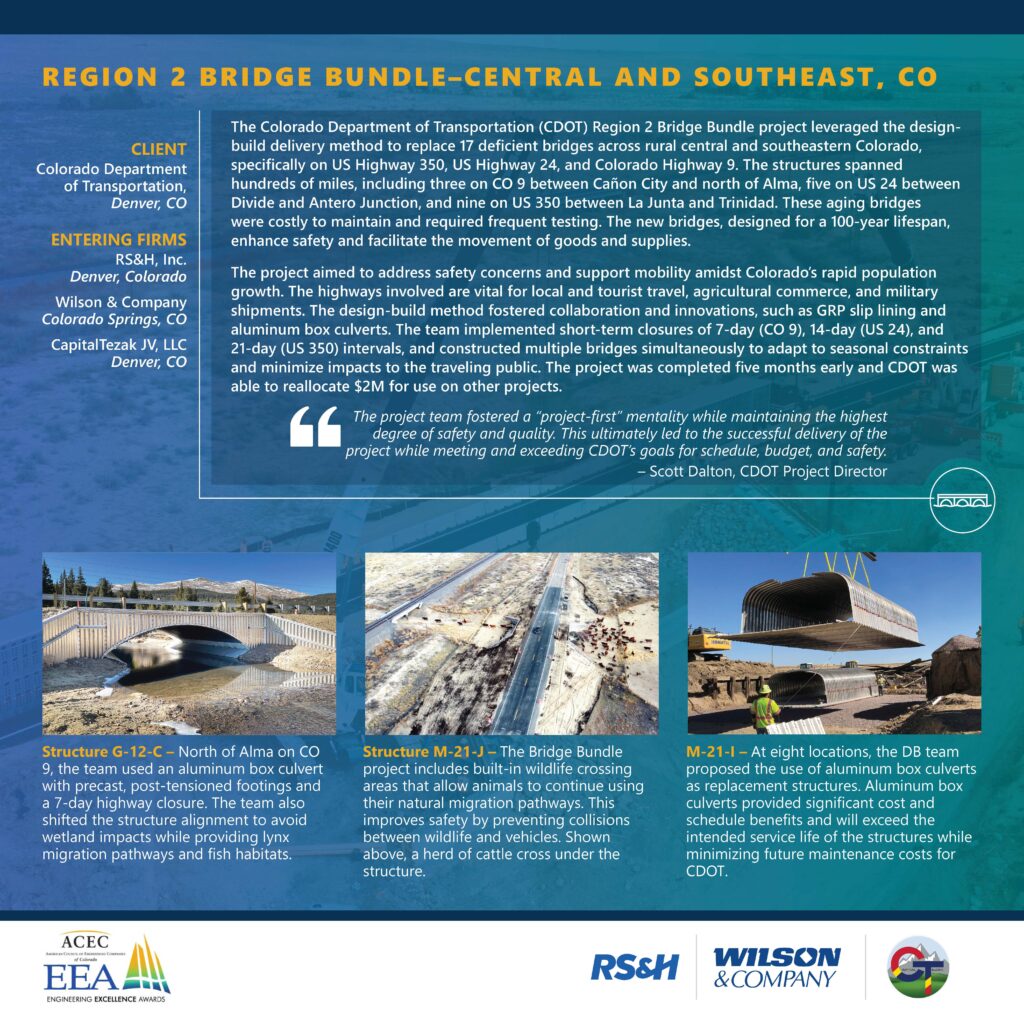The Colorado Department of Transportation (CDOT) Region 2 Bridge Bundle project leveraged design-build delivery to replace 17 deficient structures across key rural highway corridors in southeastern and central Colorado: US Highway 350, US Highway 24, and Colorado Highway 9. The structures were spread out across hundreds of miles in both mountainous and plains regions.
- Three of the structures were located on CO 9 between Cañon City and north of Alma.
- Five structures were on US 24 between Divide and Antero Junction.
- Nine structures were on US 350 between La Junta and Trinidad.
These aging structures were costly to maintain for CDOT and required frequent inspections. The new structures are designed to last 100 years and improve safety for motorists while facilitating the movement of goods, supplies, and wildlife through rural areas. CDOT relied on the CapitalTezak-Wilson design-build team and RS&H to provide design, construction, and construction management services for this important project.
The CapitalTezak Joint Venture (JV) served as the lead contractor on the design-build team, with Wilson & Company, Inc. (Wilson) serving as the lead designer. RS&H, Inc. (RS&H) provided construction management and design review services. This team understood the importance of this project for CDOT and worked as an extension of Region 2 staff.
A seamless partnership between the project team and numerous CDOT specialty units such as Traffic, Environmental, Public Involvement, Materials, Hydraulics, Civil Rights, and Staff Bridge led to a successful outcome for all parties. The team also spearheaded extensive coordination with the various affected communities throughout the project, including elected officials, city offices, ranchers, residents, and first responders.
A driving force for CDOT Region 2 in updating these structures was the need to keep pace with rapid population growth in Colorado. These deficient structures would have soon posed safety concerns and potentially limited mobility throughout the southeastern and central portions of the state. The highways involved play important roles in facilitating mobility for locals and tourists visiting popular Rocky Mountain destinations. They also support the movement of agricultural commerce and shipment of military goods to and from the US Army’s Piñon Canyon Maneuver Site.
The design-build delivery method provided a collaborative atmosphere from the start and allowed for innovations such as the use of Glass Reinforced Plastic (GRP) slip lining and aluminum box culverts. CDOT used a bestvalue selection format based on the technical proposal score multiplied by a price factor. This selection approach encouraged prospective teams to develop and present innovative, yet cost effective approaches to meet CDOT’s goals and requirements. These innovations, developed through the Alternative Technical Concept (ATC) process, helped avoid major traffic impacts during construction and contributed to time and cost savings for CDOT.
The project faced significant challenges due to the volume and distance between structures across mountainous and plains regions, impacting submittal management, communication, material transportation, and inspection coverage. Seasonal constraints and environmental challenges, including wildlife habitats and wetland impacts, required dynamic scheduling and innovative solutions. The team established protocols with CDOT, held weekly meetings, and used cloud-based documentation to address these issues.
At structures I-15-AO and I-15-T, refining the scope of roadway improvements and minimizing environmental impacts led to a three-month reduction in the construction timeframe and a return of $28,000 in cost savings to CDOT. Similarly, by combining the design and construction of structures M-22-Y, M-21-J, and M-21-I into a single package and utilizing a single 21-day full closure with an offsite detour, an additional $25,000 in cost savings was returned to CDOT.
All these cost savings reduced the initial contract value, incorporated with deductive change orders, and provided real dollars returned to CDOT for use on other priority projects to benefit the public.
CDOT’s encouragement of additional innovative ideas post-contract award resulted in $280,000 in further savings. The project met CDOT’s service life goals while minimizing public impacts during construction. The project was completed five months early, reallocating $2M back to the Colorado Bridge and Tunnel Enterprise.
